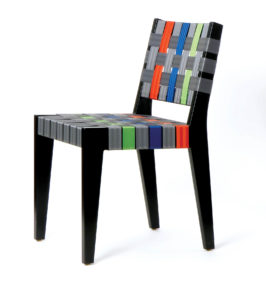
Corporate administrators tend to base management decisions on the Pareto Principle (80 percent of business comes from 20 percent of the clientele). Textile engineer Connie Huffa argues that can be a shortsighted way of thinking.
“Opportunities lie in the 20 percent—the business we all would have turned down 10 to 20 years ago,” says the co-founder of Fabdesigns Inc., a textiles innovation center in Malibu, Calif.
“I think that many companies with warp knit and weaving equipment for narrow goods are chasing vanishing margins with the trim, webbing and elastics markets,” she says. “Sometimes it takes a little bit of imagination and skill to turn these specialty fibers and yarns into a viable fabric.
“The commodity narrow goods market is finding cheaper and less-experienced places to manufacture every year,” Huffa notes. “We’ve seen some of the same equipment that we had here in the United States 30 years ago now in India and Bangladesh. So, building a future on what we made in the past does not really constitute an opportunity to make a profit.
“We need to use our equipment in different ways,” she continues. “The techniques may be old, but we can use them in new ways, with modern technical fibers—even combining them or building on after processes, films and finishes.
“Dyneema®, Kevlar®, Pyron® and stainless steel give us a new product line. The narrow goods market needs to look beyond common materials and at how we can use the precision of older machinery in a new way. This may mean working with needle companies to make stronger needles and yarn companies to make different bobbins and yarn-feed companies to come up with different ways to turn materials into fabrics. This is true innovation.”
All together now
“Ninety-nine percent of the success in our business has been due to our ability to build relationships with supply chain professionals, end to end,” says Steve Dew, president and CEO of Tennessee Webbing Products in Knoxville. “We do all we can to familiarize ourselves not only with the industries or markets they are serving and how they serve them, but also, most importantly, with their needs and frustrations. We usually then are able to come up with a plan that eliminates those issues and solves problems.”
Bally Ribbon Mills of Bally, Pa., has increased its interactions with suppliers.
“We have learned about new types of yarns by keeping in contact with them,” says Mark Harries, marketing executive. “We talk to them every day. Quality assurance requirements from our customers no longer just apply to us but must include our supply chain, so we engage our suppliers much more than before to be able to satisfy the end user.”
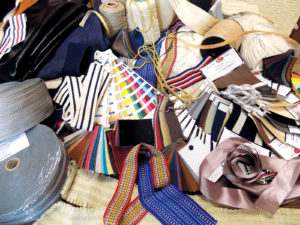
“Contact with the supply chain is most important,” agrees Hans Reiser, executive vice president of Jakob Müller of America Inc. in Charlotte, N.C., a division of Jakob Müller AG in Frick, Switzerland. “We see a good many issues on the raw material side.
“Jakob Müller of America has expanded its support toward the industry with a complete array of showroom and testing equipment and, more importantly, by maintaining a sizable stock of the most commonly requested narrow fabric machines. So if a customer has a project, we can usually bring it to realization within weeks, but no more than a few months.”
“Partnering with companies and developing innovative applications is key today, even for start-ups,” Huffa says. “Our industry needs loyalty, and that comes by working together to solve specific design and engineering problems. We have our clients work with us [in our lab], right on the machinery, so they understand what it takes. Sometimes having people with fresh eyes is really helpful for the creative process.
“They need to know how special this knowledge is, and we need to know that they are serious about a business plan,” she adds. “Most times, we need to educate our clients on polymers, fiber, yarns and structures. Changing things affects the products in ways they didn’t imagine on a computer screen or cost sheet.
“Sometimes this can drive a factory crazy. Going through it once with a team makes a big difference, and this is all part of customer service these days if we want to succeed. These small batches usually turn into large quantities and exclusives for a period of time, which makes managers happy. They get things they can’t get elsewhere.
“The other thing we do is look at what comes off the shelf from the machine builders,” says Huffa. “This is good for 80 to 90 percent of the product out there. But we modify machinery to feed different materials in and push the software and hardware to do things even the machine builders didn’t imagine.”
“Multilateral education is the key for developing ideas and bringing them to fruition,” Reiser says. “This can be achieved only by reaching out and engaging with all parts of the industry, while understanding each partner’s contribution to then solve the development puzzle.”
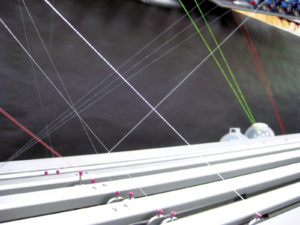
“I hope to identify markets through working with the Rhode Island Textile Innovation Network (RITIN),” says Michael Woody, CEO of Trans-Tex LLC, a narrow web dye-sublimation printer in Cranston, R.I. “RITIN is a cluster of Rhode Island-based textile companies that plans to market our supply chains to prospects in other states and even other countries. Our first step is to define our supply chain. Then we will identify markets that need what we do.”
Standing apart
“New investors with particular requirements are opening manufacturing facilities at a very brisk pace,” Reiser says. “The investments and start-ups are not necessarily related to new technologies, but rather geared to satisfy specific,
value-added product needs.
“Jakob Müller is very much interested in connecting with customers that have specific needs in order to find individualized solutions,” he adds. “We are reinvesting in the presentation of highly specialized machinery at textile-related exhibitions like IFAI’s Expo.”
“One of our strengths is identifying specific needs for narrow fabrics and then helping customers save money through using high-quality alternative materials,” Dew says. “For many years, companies that could use repurposed webbing would not, due to the nature of seconds or overrun materials. It may be off-shade or mixed with many colors or have too many splices, causing increased labor or waste. Manufacturers could never be 100 percent sure what they were buying until they received it. We made the decision to invest our labor into sorting and grading all incoming webbing. We are able to send customers what they want the first time and every time.”
Harries notes that Bally Ribbon Mills derives new business from a mix of product development and finding new uses for current items.
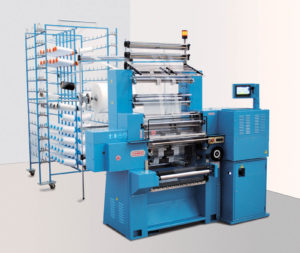
“We are looking at a new line of E-WEBBINGS® for the internet of things market, trying to find a place where we can add value for our customers,” he says. “We see webbing as a good vector for inserting data sensors and power transmitters, because webbing creates structure within a lot of products. For example, if you had a safety harness and wanted to measure environmental stresses such as hazardous materials, you would have to build the component, sew the harness, and attach a battery and add wires. That would be an extra set of steps and bill of materials. The webbing is already an integral part of the product. So with [embedded components], the manufacturer can make the harness as usual.
“We know that to survive in a niche market, we have to be able to meet customer needs and know that things are going to change and be prepared for it as best we can,” Harries adds. “We like to stay nimble, so that if a customer comes in for a special item, we can turn that around quickly, whether it’s figuring out engineering or how to modify a loom to do something that couldn’t have been done before.”
In order to expand its tape-manufacturing capabilities, NC Carpet Binding & Equipment of Newark, N.J., recently purchased an overseas mill, which it has been in the process of relocating to New Jersey and expects to have running early in the first quarter of 2018.
“Our platform is going to be the ability to offer autonomous designs—to empower prospective clients to design and creatively present their ideas vs. force-feeding them with set product lines, fabric limitations and application limitations,” CEO Mal Maher says. “We are equipped to run most any fabric and focus on custom, client-driven designs. Also, we’re launching the NC Executive Line, a high-end line of 35 cotton and polyester tapes in 3- and 5-inch widths. It boasts all new designs and will be sold in 25-yard increments, which is half the current industry offerings.”
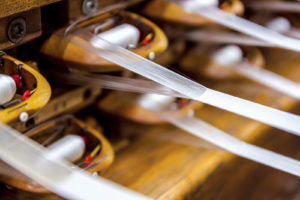
Woody attributes Trans-Tex’s growth over the past three years to investment in digital technology for production equipment to produce shorter, more customized runs.
While companies that manufacture a product that serves one function in a massive market may be able to focus on the ocean surrounding them, businesses
in the narrow fabrics industry need to eye the horizon for an island here and there.
“One of the challenges of selling narrow web fabrics is that the product is used by a wide range of companies in a variety of markets,” Woody says. “This means that what we call ‘the narrow web market’ is actually a lot of niche markets.”
Janice Kleinschmidt is a writer and magazine editor based in Palm Springs, Calif.
Straps and slings, tie-downs and seat belts, rigging and trims—the range of industries that employ narrow fabrics is endless. Their use goes above and beyond anything you can think of on Earth: Consider Bally Ribbon Mills’ thermal protection system for NASA’s Orion capsule to enable space flight to Mars and other planets.
And while Fabdesigns Inc. concentrates on the automotive, medical and footwear industries, the innovation center is starting to work on architectural applications. “We are developing a fabrication that will help reinforce concrete in specific areas that have a propensity for failure,” Connie Huffa says, adding that her company is building supply chains simultaneously with building platforms. “We are developing narrow fabrics to support projects and educating our clients’ existing suppliers on how to manufacture them in production runs,” she notes.
“Business has become lean, and the 80/20 rule usually prevails. We have to figure out ourselves how to make real products our clients wish existed.”
“Do a lot of it. You can’t be in only one niche market, because there isn’t a lot of scale. You have to go out and find many niche markets and figure out how your products can fit within a diversified field.”
Mark Harries
Bally Ribbon Mills
“When you customize, you don’t often receive substantial return on investment. But coming through for a client on a special need will earn their future business on stocked goods as well. It’s all about trust and relationships. Bringing a client’s vision to life is rewarding and builds loyalty.”
Mal Maher
NC Carpet Binding & Equipment
 TEXTILES.ORG
TEXTILES.ORG


